
It’s mid-afternoon in Clock Tower Square in the Bhutanese capital, Thimphu. Prayer flags flutter in the breeze against an ice-blue sky, mountain peaks melt into the horizon and the crowd, complete with crimson-clad monks, jostles for space on the stone steps. As the sound of hip-hop fills the air, dance troupes with names like Urban Boomers and Half Dead Guys take to the stage. Bhutan’s first-ever street dance battle is under way and it’s serious stuff.
It may not be the first thing you’d expect in this remote Himalayan kingdom – a mystical Buddhist nation that famously measures gross national happiness instead of GDP – but the show is part of the brand new Annual Bhutan International Festival. A 10-day programme of art, music, film and food, held for the first time in February, it’s all about collaboration between nations and across genres. London choreographer Jade Shaw has been working with local youngsters, who had previously relied on YouTube to learn dance moves, weaving in messages about leadership and respect along the way. It’s a triumph. Rapturous laughter and applause erupt from the audience, most of whom have never seen anything like this.
Landlocked between giants India and China, tiny Bhutan is one of the most intriguing countries in the world. Tourism was not permitted until 1974 (it remains tightly controlled) and the country’s ancient culture thrives almost intact. The street dance session is held on the birthday of much-loved King Wangchuck and the crowd – the men all wearing a gho, a tunic with big white sleeves, the women in colourful ankle-length kira dresses – have already enjoyed a morning of traditional celebrations, with masked dances, strong-man races and archery competitions in the town’s stadium.
But with the arrival of the internet (television was only allowed in 1999), a curious young population (60% of the country is under 25) is dipping its toe into the world outside.
“Bhutan hasn’t been open very long,” says festival co-founder Thinley Palden Dorji. “We’ve protected our culture, but change is inevitable. The influence of the world is there: it’s now a question of how we engage with it. The festival aims to give the youth a platform to express themselves, learn from international artists and share ideas.”
In a world saturated with festivals, this one is set apart by more than its unusual, beautiful location. It’s the first project from EdenLAB, a new creative touring initiative from Cornwall’s Eden Project. More than 100 international artists, performers and thinkers have been brought in to work alongside 200 local artists, with the aim of creating a lasting legacy, providing funding for the arts and setting up ongoing workshops and long-term relationships. Smaller events are planned throughout the year to maintain the momentum. And with Queen Jetsun Pema on board as patron, it has had a very big Bhutanese thumbs-up.
“The vision is for a world-class festival that’s unique in its focus on collaboration and community,” says co-director Ginny Galloway. “It’s about youth and legacy and the fusion of a culture that’s so intact with that of the modern world.”
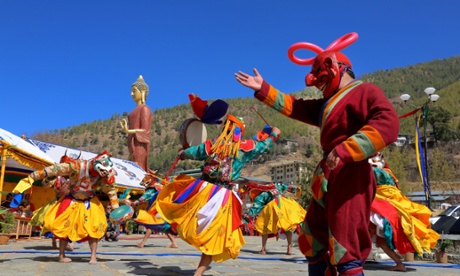
Costumed monks from Majuli, India, perform a traditional dance at the festival. Photograph: Lisa Russell
February is low season for tourism, so boosting visitor numbers and injecting cash into the economy is part of the plan, too. And though lacking the colours of spring or the lushness of the late summer, it’s is a time of crisp, days and freezing, star-filled nights – and the king’s birthday and Buddhist new year celebrations are the same week.
Arriving in Bhutan was an adventure in itself. The flight into Paro airport skims the Himalayas: all faces were glued to the windows for a glimpse of Everest. Then it was an hour’s winding drive past paddy fields and lost-in-time villages to the capital.
It doesn’t take long to get the lie of the land in Thimphu, population 100,000. The Wang Chhu river skirts its western edge and, on a hilltop, a 51-metre-high gilded Buddha, one of the largest in the world, overlooks the city. This is the only capital in the world with no traffic lights: white-gloved police direct traffic from a prettily painted stand in the main roundabout. There’s an almost medieval feel about the old centre, with its wooden-shuttered buildings; the vibe is remarkably laid-back and the people gentle.
It’s a short walk between festival venues, and Coronation Park, by the river, is the site of most of the art programme. I watch sculptors from Cornwall crafting a huge snow leopard and a horse out of bamboo and paper; artists from VAST Bhutan, the country’s only contemporary arts centre painting people’s portraits; and potters from South Africa swapping techniques with local artists.
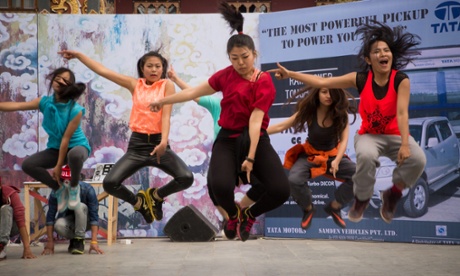
Jade Shaw Street Dance at the festival. Photograph: Jigme Noko Dorji
Most intriguing perhaps is Dance Spectroscopy, an art-meets-science affair which makes invisible particles in the atmosphere around you visible on a big screen, and creates a soundscape as you move. A group of children giggle and play, fascinated by the shapes and music. In a dome tent next door, British sonic artist Mileece has crafted a musical Eden, where plants play tunes when touched.
For those made peckish by all that art, Clock Tower Square is full of food stalls offering Bhutanese regional specialities (buckwheat pancakes from Haa in the west, yak skin stew from northern Gasa, jomja rice patties from Paro). Los Angeles chefs Roxana Jullapat and Daniel Mattern are here too, learning about Bhutanese fare and running workshops for local chefs.
As the days unfold, a constant stream of talent takes to the stage – monks from Majuli, in the Indian state of Assam, perform a mesmerising dance, then Bhutanese rock band Flying Kik scream out Rage Against the Machine covers. Other surprises are the beatboxers – MC Xander and Bellatrix from the UK, and Chesney Snow from the US, and rapping from BBC4 Poetry Slam champion Dizraeli.
As darkness and the temperature falls, the action moves to Mojo Park, a bar and music venue where visitors might catch musicians from the Harvard-Radcliffe Orchestra jamming with Bhutanese guitarists and beatboxers – or Indian pop star Lucky Ali and Mercury-nominated UK indie folk artist Nick Mulvey treating fans to an intimate gig before their stadium turn. Later, night owls head to Vivacity, a nearby club with guest DJs each night. In such an intimate setting it feels like one big party. There’s a constant buzz in the air – the Bhutanese hosts and artists excited to have the festival in town, visitors simply excited to be here.
Another thing that’s different from your average festival is that everyone stays in hotels. My base is the brand new Le Meridien, the biggest in Thimphu with 78 rooms, and a major festival sponsor. It’s here that the film events take place (Woodstock Film Festival is an adviser) and there are TEDx and TEDx Youth talks to coincide with the festival. Inspiring speakers muse, appropriately, on the theme of happiness, and eloquent Bhutanese children tell of the reality of life here – with, as everywhere, problems of drugs, depression and suicide.
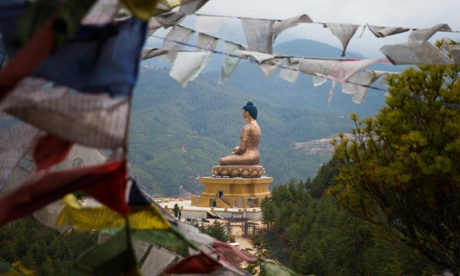
In Thimphu, an enormous Buddha overlooks the capital. Photograph: John Hendicott
Screenings and workshops are led by artists ranging from Grammy-nominated musician Duncan Bridgeman of 1 Giant Leap and double Sundance winner Ondi Timoner (whose documentary on Russell Brand has just debuted at SXSW), to Bhutanese actor and director Loday Chophel. Ideas are exchanged, practical advice given and plans hatched for films to be made by locals for screening next year..
I sign up for a workshop with Argentinian photographer Sebastian Suki Belaustegui, and we venture out to a village to practise portraits. Just 20 minutes from the city, we’re in a world of wood-and-mud farmhouses with oxen ploughing the fields. We’re invited in to a home where a new year blessing is taking place. The candlelit shrine room (there’s one in every house) is full of chanting monks and we’re offered puffed rice with sweet milk as a blessing.
From Thimphu it’s possible to take excursions to key sites, but the “low-volume, high-value” approach means tourists have to use a tour operator, and packages require a minimum spend of $200 a day ($250 in high season). These have to be paid for before a visa is granted. For those used to independent touring, this can feel restrictive and pricey, but it does cover all accommodation, food and transport.
As the festival draws to a close, I take a trip with British company Mountain Kingdoms, which has been operating here since 1986. Bhutan is a mecca for trekkers looking for mountain hikes and remote camping, but I opt for a gentler trip, combining day walks with comfortable hotels.
It’s a spectacular winding drive north to Punakha, over the 3,000-metre Dochula pass, which is crowned with 108 stupas in memory of Bhutanese soldiers killed fighting Indian insurgents in 2003. The sky is cloudless and the views across the eastern Himalayas include Gangkhar Puensum, the highest peak in Bhutan at 7,570 metres, and a candidate for world’s highest unclimbed mountain.
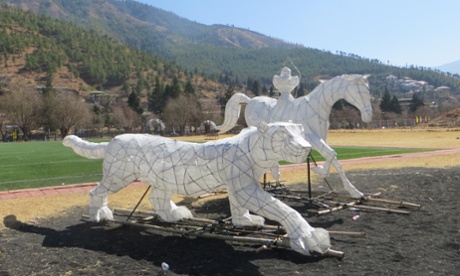
At the festival, sculptors from Cornwall created this snow leopard and horse out of bamboo and paper Photograph: Sue Hill
On the other side, much-needed work to widen the road sporadically stops our journey. Locals make the most of the queues by selling us tea and momos (dumplings), and there are also stalls selling apples and tough little blocks of dried yak’s cheese. I watch a man repeatedly prostrating himself and rising again, moving slowly along the side of the road. “He’s earning spiritual merit – it might take him a month to reach Punakha,” says Yeshi, my guide.
At the confluence of the milky Pho Chhu and Mo Chhu (Mother and Father) rivers stands Punakha Dzong, a white-walled, red-roofed fortress and monastery. In its courtyard, rehearsals for a festival of a different kind are under way – the Punakha Drubchen is a dramatic recreation of a 17th-century battle against the Tibetan army. Inside the temple, masked men in full-skirted costumes dance to hypnotic chanting. We wander the intricately painted rooms, then picnic on the riverbank under the jacaranda trees, tucking into rice and ema datshi or chilli cheese (chillies are used as a vegetable in Bhutan, and ema datshi is the national dish).
The Bhutanese calendar is full of celebrations marrying religion and myth. The country’s history is intertwined with magical, fairytale-like tales of reincarnated rulers and lama-saints fighting the demons who opposed the spread of Buddhism. Perhaps the most curious of the saints is 15th-century Drukpa Kunley, the “Divine Madman”, a revered womaniser and drinker. As you trek to the monastery devoted to him, Chimi Lhakahy, it’s hard not to notice the giant penises painted on the walls of houses in his honour – a symbol of fertility and protection from evil. Those looking to conceive come here to be blessed, and an album inside holds photos and thank-you letters from across the world.
Days pass in a blur of beautiful scenery and hikes to remote and romantic sights, with plenty legend, history and happiness from Yeshi. King Wangchuk, the fifth king, is known as K5 and seems to be universally loved by his people. “Of course we’re happy: we have a benevolent king,” says Yeshi, listing K5’s good deeds.
Bhutan takes conservation seriously, plastic bags are banned, 65% of the land is forested and large swathes are protected. We walk through pristine woodland to a convent called Kila Gompa: the route is lined with rhododendrons come spring, but snow and ice crunch underfoot today. Clinging to the mountainside, it is home to 45 shaven-headed nuns who happily offer us butter tea.
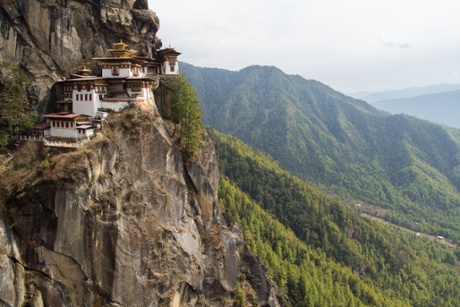
Taktsang Palphug, or ‘tigers’ nest’ monastery, on the cliffside of the upper Paro valley. Photograph: John Hendicott
The Haa Valley, bordering Tibet in the north-west, didn’t open to tourists until 2002. Yaks graze in fields, and it feels like we’ve stepped back in time once more as we arrive at Lechuna Heritage Lodge – a 100-year-old farmhouse where I’m the only guest. The owner’s nephew cooks me dinner and I fall asleep as snow starts falling outside.
On my last day, I hike to perhaps the most-photographed site in Bhutan – Taktsang monastery, or Tiger’s Nest, on a cliff 900 metres above Paro valley. Legend has it that Indian guru Padmasambhava flew here from Tibet on the back of a tiger. I, however, climb for two hours through ancient forest splashed with colourful prayer flags, but it’s worth every step.
I feel I have hardly scratched the surface of this land of happiness, benevolent royals, jaw-dropping beauty and magical saints. A visit at any time is an extraordinary experience. A visit during the International Festival adds another dimension: a glimpse of an ancient realm’s first steps towards engaging with a more complicated world.
• The trip was provided by Bhutan International Festival (bhif.org) and Mountain Kingdoms (mountainking-doms.com). The next festival will be in February 2016, dates TBC. Most events are free. A 16-day Gentle Walking Bhutan trip with Mountain Kingdoms costs from £3,225pp with flights and all meals. Tailormade options available
This article originally appeared on guardian.co.uk
This article was written by Jane Dunford from The Guardian and was legally licensed through the NewsCred publisher network.
![]() https://images2.newscred.com/cD1jMDY5MGZkNDEwNjM3N2E4YTlmZGUxZDNjODcxZGVhMSZnPWZmOTlmMzkwMWZjOThlYWMzYjkyMGY1NDBmMWJhZjg1
https://images2.newscred.com/cD1jMDY5MGZkNDEwNjM3N2E4YTlmZGUxZDNjODcxZGVhMSZnPWZmOTlmMzkwMWZjOThlYWMzYjkyMGY1NDBmMWJhZjg1